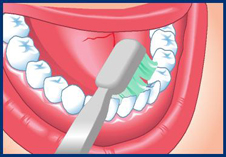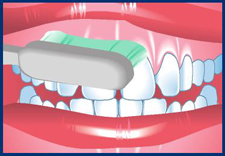Cleaning teeth of young children
Young children are not able to clean their own teeth. As a parent, you must do it for them when they are very young and do it with them, as they get older.
When your child can write (not print) his or her name, your child is ready to do a good job brushing. You should check to make sure your child does a good job.
You should start cleaning your child's mouth even before your child has teeth. It gets both you and your child into the habit of keeping the mouth clean, and it gives baby (or primary) teeth a clean place to come into. The goal is to wipe all parts of the gums and teeth.
Here's how to do it:
- Lie your baby in a comfortable place.
- Make sure you can see into your baby's mouth.
- Use a soft baby brush or wrap your finger in a clean, damp washcloth. Then, brush or wipe your baby's gums and teeth.
- Do not use toothpaste until your child has teeth.
How to Brush
Step 1
Hold the toothbrush at a 45-degree angle to the teeth. Point the bristles to where the gums and teeth meet.
 |
 |
Step 2
Use gentle circles. Do not scrub. Clean every surface of every tooth. For the front teeth, use the "toe" or front part of the brush. The key word is gentle. You can hurt the gums by brushing too hard.
Toothbrushes
The best kind of brush is soft, with rounded bristles. It should be the right size for your child's mouth. You will need to buy a new toothbrush at least every 3 or 4 months.
Children can be hard on toothbrushes. If the bristles get bent or worn down, they will not do a good job, and may hurt your child's gums.
Toothpaste
Make sure the toothpaste has fluoride. Check the box or tube for the symbol of the Canadian Dental Association. This symbol means the toothpaste has fluoride. Use only a bit of toothpaste and make sure your child spits it out.
As excessive swallowing of toothpaste by young children may result in dental fluorosis, children under 6 years of age should be supervised during brushing and only use a small amount of toothpaste.
Children under 3 years of age should have their teeth brushed by an adult. The use of fluoridated toothpaste in this age group is determined by the level of risk. Parents should consult a health professional to determine whether a child up to 3 years of age is at risk of developing tooth decay. If such a risk exists, the child's teeth should be brushed by an adult using a minimal amount (a portion the size of a grain of rice) of fluoridated toothpaste. Use of fluoridated toothpaste in a small amount has been determined to achieve a balance between the benefits of fluoride and the risk of developing fluorosis. If the child is considered to be at low risk, the teeth should be brushed by an adult using a toothbrush moistened only with water.
Children from 3 to 6 years of age should be assisted by an adult in brushing their teeth. Only a small amount (a portion the size of a green pea) of fluoridated toothpaste should be used.
How to Floss
Step 1
Take a piece of floss about as long as your child's arm. Wrap it around your middle fingers, leaving about 2 inches between the hands. Use your index fingers to guide the floss between the teeth.
|
|
|
|
Step 2
Slide the floss between the teeth and wrap it into a "C" shape. It should wrap around the base of the tooth, where the tooth meets the gum.
Step 3
Wipe the tooth from bottom to top 2 or 3 times or more, until it is squeaky clean.
Be sure you floss both sides of each tooth, and don't forget the backs of the last molars.
Move to a new part of the floss as you move from tooth to tooth. After flossing, roll it up in a tiny ball and put it in the garbage. Never flush floss down the toilet.
Should my child always brush right before bed?
Yes. If you don't get rid of the germs (bacteria) and sugars that cause cavities, they have all night to do their dirty work. Plus, when your child is asleep, he or she does not produce as much spit (or saliva). Saliva h
Dental Development
All twenty baby (or primary) teeth come in by the time your child is two or three years old.
Primary Teeth
This chart tells you when baby teeth come in (or erupt) in most children.
If your child is getting his or her teeth and seems to be in pain, you can:
-
rub the gums with a clean finger, or
-
rub the gums with the back of a small, cool spoon.
-
If your child is still unhappy, your dentist, pharmacist or doctor can suggest an over-the-counter medicine to ease the pain.
Here's what you should not do:
-
Do not use the kind of painkiller that can be rubbed on your child's gums. Your child may swallow it.
-
Do not give your child teething biscuits. They may have sugar added or contain hidden sugars.
-
Do not ignore a fever. Getting new teeth does not make babies sick or give them a fever. If your child has a fever, check with your doctor.
Permanent Teeth
At age six or seven, the first adult (or permanent) teeth come in. They are known as the "first molars," or the "six-year molars."
They come in at the back of the mouth, behind the last baby (or primary) teeth. They do not replace any primary teeth.
Also at around age six, children start to lose their primary teeth. The roots slowly get weak, and the tooth falls out. Children lose primary teeth until they are about 12 years old.
It's okay for children to wiggle their primary teeth if they are loose. But it's not okay to use force to pull out a tooth that's not ready to come out. When a tooth comes out at the right time, there will be very little bleeding.
Why do the new permanent teeth look yellow?
Permanent teeth often look more yellow than primary teeth. This is normal. But it could also be caused by medicine your child took, by an accident that hurt a primary tooth, or by too much fluoride. Ask your dentist about this when you go for a dental exam.
Healthy Gums
Cavities are the main problem children have with their teeth. But children can get gum disease too, just like adults. It happens when the gums that hold our teeth in place get infected.
Daily brushing and flossing can stop gum disease. If your child's gums bleed, don't stop brushing. If the gums are always swollen, sore or bleeding, there may be a serious problem. You should take your child to the dentist.
Dental Safety Here are some ways to protect your child's teeth:
-
Always use infant car seats and seat belts when you drive.
-
Babies will chew on almost anything. Keep them away from hard things that could crack their teeth.
-
Children fall a lot when they are learning to walk. Teeth can break, crack, get knocked out or become loose. See your dentist if this happens.








